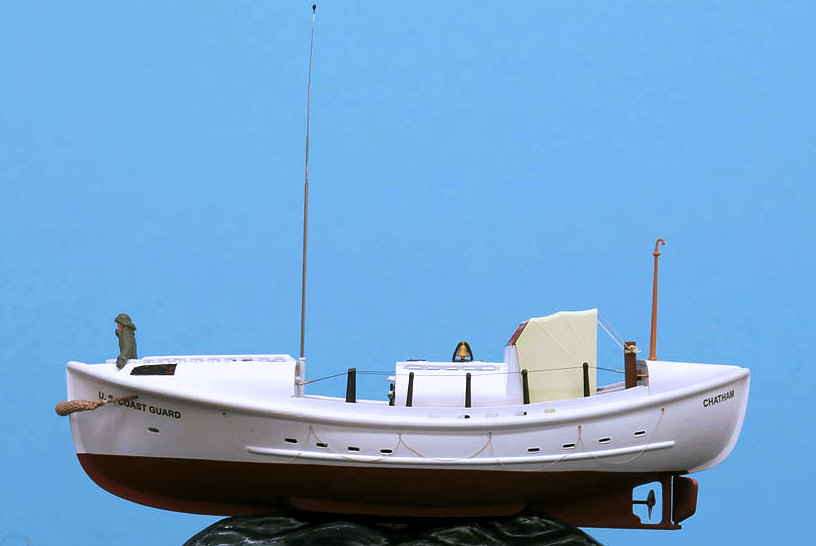
Glencoe 1/48 US Coast Guard Lifeboat
| KIT #: | 05301 |
| PRICE: | $14.98 MSRP |
| DECALS: | One option |
| REVIEWER: | Bill Michaels |
| NOTES: | Pip Moss decals |

| HISTORY |
The U.S. Coast Guard's 36 foot Motor Lifeboat (MLB) entered service in 1929 as the “Type T”. During the period 1929-1931, 27 boats were built at the Coast Guard Yard in Curtis Bay, MD. This boat was then followed by the “TR” version (Type T, Revised), which implemented a number of improvements. Sixty-nine were built between 1931 and 1937. In 1937, the design was improved again, to reduce complexity, maintenance needs, and cost of production. (Most of the bright work was removed or painted, for example, making the boat more utilitarian looking.) This final version, called the Type TRS (Type T, Revised, Simplified) was built from 1937 through 1956. There were 138 boats built.
The boats featured very strong wood construction, with a bronze keel to make them self-righting. The boats were self-bailing, and tests showed that a fully flooded cockpit would drain through the scuppers in under 15 seconds. The 36 footer was the service's standard lifeboat from 1937 until the mid 1960s, when the new steel-hulled 44 footer started to replace them. The last 36 footer was finally retired in 1987.
CG 36500 and the SS Pendleton Rescue
In February of 1952, a massive Nor'Easter hit the waters off Cape Cod, Massachusetts. Riding out the storm were a couple of WW-2 surplus T-2 tankers. The T-2 tankers had been built quickly during the war years using low quality steel, because many didn't survive for long in U-boat infested waters. The steel in these ships became especially brittle in cold weather. This storm was so fierce that two T-2 tankers broke in two- the other being the Fort Mercer, about 20 miles offshore. (That's a whole 'nother story- I'm just going to focus on the Pendelton and the CG36500.)
The date was February 17, 1952. All day long, the storm
raged, and the SS Pendelton labored as the seas continued to build, putting
tremendous stresses on the hull. Around dawn on the 18th, in 70 knots
winds and seas now hitting 60 feet, the Pendleton, fully loaded with kerosene,
took a tremendous blow from an e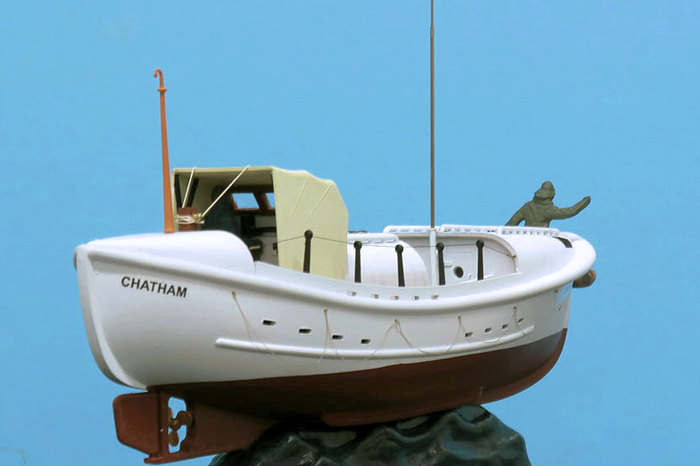 specially large wave and the crew heard a sharp
bang/cracking noise. One of the engineers ventured forward to see what had
happened, and was stunned to find that the ship had just broken in half-- with
no sign of the bow section visible in the darkness and driving snow. The eight
men in the forward section, including the Captain and all but one of the ships
officers (the Chief Engineer) were lost. With them went the now useless ship's
radios, as all power came from the generators in the stern part of the ship. As
a result, no SOS was sent.
specially large wave and the crew heard a sharp
bang/cracking noise. One of the engineers ventured forward to see what had
happened, and was stunned to find that the ship had just broken in half-- with
no sign of the bow section visible in the darkness and driving snow. The eight
men in the forward section, including the Captain and all but one of the ships
officers (the Chief Engineer) were lost. With them went the now useless ship's
radios, as all power came from the generators in the stern part of the ship. As
a result, no SOS was sent.
Thirty-three men were on the stern section, which still had power, but no radios or other way to send an SOS. Eventually the hulk drifted with in range of the radar at the Coast Guard Station Chatham. The station asked a PBY en route to another location to check out the blip, and was stunned when the pilot reported it was the stern of a tanker.
Boatswain Mate First Class Bernie Webber was told to pick a crew and take the 36500 out to assist the tanker, in case there were any survivors on board. Three men volunteered to be his crew, and they made preparations to get the boat underway. By the time they were leaving Chatham harbor, night had fallen, and the storm was driving the snow sideways in the 70 knot winds.
Chatham harbor is on the outside of the “elbow” of Cape Cod, separated from the Atlantic by the Chatham bar. The entrance to the harbor is a narrow passage, an area where the bottom shallows quickly, causing the waves to amplify and break with dangerous force. BM1 Webber had to get the 36500 over the bar. As Webber and his crew were about to to leave, a local fisherman told him, “If I was you, I'd get lost”-- implying that they were heading out on a suicide mission. They were heading out over the treacherous bar into a blinding storm at night in a small boat with nothing to navigate with besides a compass.
As Webber and his crew approached the bar, a mountainous breaking wave tossed the boat in the air and it landed on its side in the wave trough. The boat righted itself, but the wave had broken the windscreen and tore away the compass. Webber pushed on, and after several additional close calls, eventually the boat made it past the bar and in the open ocean.
Webber and his crew were now on the open sea in a 36 foot boat, in a blinding snowstorm and 40-60 foot waves, with not even a compass to guide them. Webber altered course a bit, hoping to sight the Pollock Rip lightship to get a bearing and a respite from the ferocious seas. But CG36500 never made it to the lightship-- at one point Webber had “a feeling” and slowed the boat to a near stop. Webber had one of the crew turn on the boat's small searchlight. The light illuminated a seemingly giant wall of twisted and broken metal-- they had almost sailed right into the Pendelton's stern section!
The small boat circled the huge hulk, examining it with the searchlight. They were surprised to see a large group of men by the rail. When they saw the boat, the men threw a Jacob's Ladder over the side and men became climbing down. Webber spent the next hour maneuvering his little boat in close enough to the huge, rolling hulk to snatch men from the ladder or out of the sea when they fell or missed their jump to his small target.
When he got to 21 men aboard, he stopped to consider his options. The 36 footer was designed to carry up to 12 survivors, and he had 21 aboard, with another dozen still in need of rescue. Should he get the men he had to safety and come back for the rest? Was there enough time? Would he be able to get out across the bar again? And if he did, how would he find where the stern had drifted off to in the dark and towering seas?
After considering all this, Webber
decided to go ahead to save “all or none”. He continued to maneuver the
overloaded and ever-more sluggish 36500 back alongside the big hull, knowing
that his ability to avoid
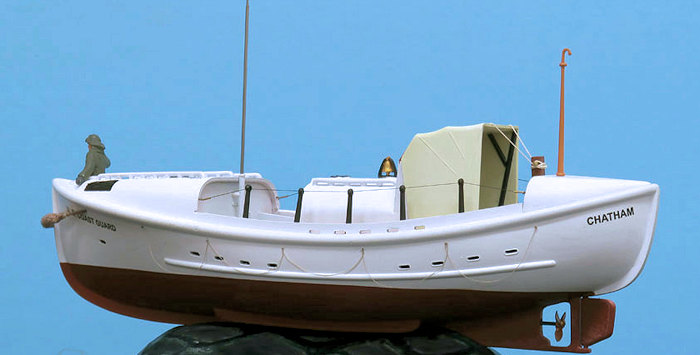 a disastrous and likely fatal collision with the
tanker was lessening. Webber and his crew pressed on, and eventually rescued 32
of the 33 men. (The last man was lost when he fell from the ladder, was hit by
the boat when it couldn't reverse in time, and was swept away by the seas, never
to be seen again.)
a disastrous and likely fatal collision with the
tanker was lessening. Webber and his crew pressed on, and eventually rescued 32
of the 33 men. (The last man was lost when he fell from the ladder, was hit by
the boat when it couldn't reverse in time, and was swept away by the seas, never
to be seen again.)
Webber now had a seriously overloaded boat and no way to navigate back to shore. He had only a vague idea of there he was, but he knew that if he put the waves behind him, he'd hit the beach of Cape Cod somewhere. He decided he'd head for the shore, run the boat aground, and get everyone off as best they could.
But luck was still on his side-- as boat lumbered along, the crew saw a flashing red light. It was the entrance buoy for Chatham Harbor! Webber tried his radio, was surprised it worked, and was able to tell the station he had 32 survivors on board, and was headed for the main dock. Word spread quickly, and the whole town turned out to meet them, to help take care of the badly shaken survivors. A local Cape Cod newsman was there, and he took the famous shots of the boat and the bedraggled crew.
The loss of the two tankers and the ensuing rescues hit the news wires, and became a major national news story. Webber and his crew were awarded Gold LifeSaving Medals, in a ceremony held later in Washington, DC. It is probably not a coincidence that ITC came out with a Coast Guard 36 foot MLB model kit a few years later...!
I've only hit the bare essentials of the story. The book “The Finest Hours” has the full tale of both the Fort Mercer and the Pendleton rescues. It is a great read, and is highly recommended.
After over 20 years of hard service, the 36500 was retired by the Coast Guard in 1968. It spent the next 13 years on a cradle with a small plaque as a sort of historical marker along the Cape Cod National Seashore. In 1981, the Orleans (MA) Historical Society acquired the boat, and began plans to restore it. The restored boat is now on the National Register of Historic Places, and is maintained and operated by the Historical Society. The boat is moored in Orleans, and can be visited there. My wife and I took a couple hours and drove down to Chatham and Orleans to visit the boat and the CG Station on a brisk, sunny Sunday afternoon in mid-March. Conditions on the bar were fairly calm, but would sit would still have been a cold, damp ride to cross it in a 36 foot open boat! While I spent some of my Coast Guard time at sea in bad weather, it was on a much larger vessel, and not as bad as the weather Bernie Webber and his crew faced in 1952. It was a humbling and inspiring visit.
| THE KIT |
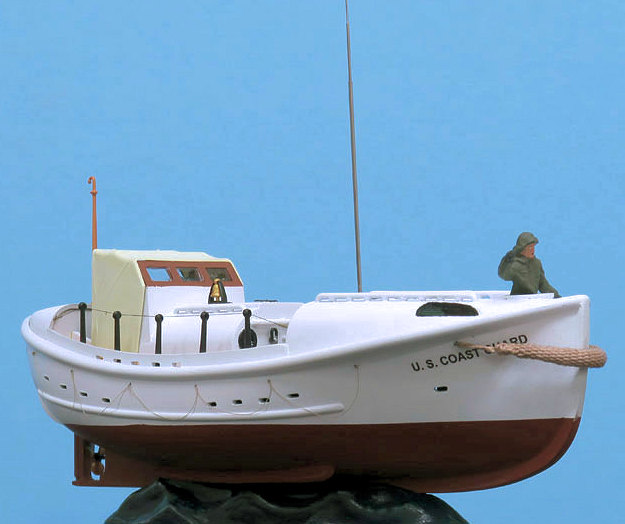 Glencoe Models has had
success in taking old molds (ITC, Aurora, etc.) cleaning them up, and putting
them pack into production. This one is
an old kit-- it was originally an ITC (Ideal Toy Corp.) mold from the mid-late
1950s. In 1/48 scale, the model is about 9 inches long. As you'd expect, the kit
is simple, with little surface detail, but the fit is OK, and the shapes are
pretty accurate. The old molds “feature” raised molded detail and markings--
you'll want to sand them off and use decals.
Glencoe Models has had
success in taking old molds (ITC, Aurora, etc.) cleaning them up, and putting
them pack into production. This one is
an old kit-- it was originally an ITC (Ideal Toy Corp.) mold from the mid-late
1950s. In 1/48 scale, the model is about 9 inches long. As you'd expect, the kit
is simple, with little surface detail, but the fit is OK, and the shapes are
pretty accurate. The old molds “feature” raised molded detail and markings--
you'll want to sand them off and use decals.
My Glencoe version of the kit is probably 15-20 years old, and was molded in dark brown. If you're interested in building this kit, having a later edition will be easier to paint. Kits molded in the 2000s were molded in brown. Starting in 2010, they were molded in neutral gray, switching to white in 2015.
The kit includes an “Ocean Wave” stand, and three figures. The figures aren't bad, especially considering how old they are. Most editions of the kit do not come with decals or flags, but it is easy to make your own.
| CONSTRUCTION |
The kit isn't all that complicated, and goes together pretty easily. I found it easier to paint the model along the way, to avoid the need for a lot of masking. My basic assembly sequence was:
Assemble the hull and main deck.
Scribe in the missing doors on the bulkheads.
Prime and paint the hull, and all the cabin pieces. (Basically everything that was getting painted white.
Install the cockpit tubs.
Assemble the cabins. I installed the bulkheads first, to minimize gaps and seams where they met the tubs.
Add extra detail.
It is a 50+ year old kit, however, so there are a lot of places where gaps or seams appeared. I used Vallejo white filler- the one with the nozzle applicator. It was easy to apply the primer, smooth it with a wet cotton bud, and then touch up the paint with a brush after it dried.
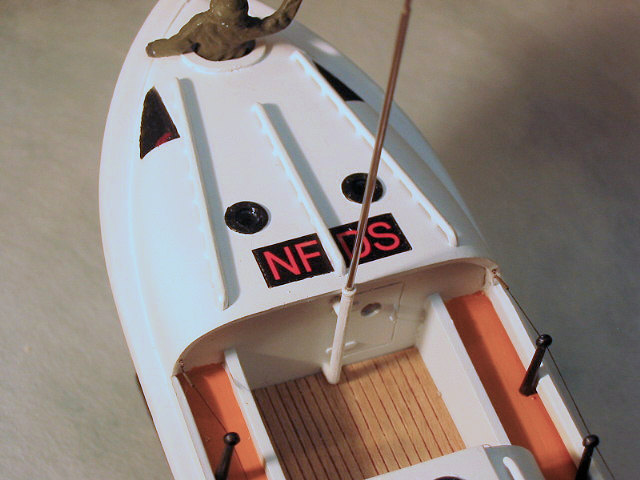 While the kit's detail parts all
looked OK after cleaning them up, there weren't a lot of them. There are a lot
of ways the kit can be improved. Here's a description of the improvements I
made:
While the kit's detail parts all
looked OK after cleaning them up, there weren't a lot of them. There are a lot
of ways the kit can be improved. Here's a description of the improvements I
made:
The hull has raised outlines for the scuppers (where the water would drain out of the cockpits.) They are easy to drill out and clean up with a small file, which really improves the look.
The bulkhead to the forward survivors' cabin has no door detail. I scribed in the small rectangular door and added some strip styrene hinges, and a handle made from fine brass wire.
The bulkhead next to the helm (entrance to the engine room) likewise did not have a door, so it got the same treatment.
Ditto for the missing door into the steering gear compartment.
The helmsman's station only has a wheel, and no other detail. I used a small decal from the scrap bin to provide the small engine instrument panel-- a small black square with 3 dials looked very convincing.
I scratch built a domed compass out of piece of thick sprue, sanding the top round. I painted it black and added small round pin heads painted red and green on either side. On the boat, the compass was mounted on a small wedge of wood on top of the dash to level it out-- I sanded and stained a small piece of balsa, which filled the bill.
There was no throttle in the kit parts, so I sanded a small block of styrene to shape, painted it, and added a small decal scrap to simulate the metal indicator plate. The throttle lever itself was made from a round topped pin, bent to shape and painted.
The deck pieces in the two cockpit areas had raised wood grain detail, unfortunately marred with a pair of big ejector pin marks. Rather than try to fix that, I sanded off the “wood grain” and added a thin layer of wood veneer. I took a piece of 1/64 ply, and scribed in the plank lines. I then used a wood stain marker to color it. The stain collected in the grooves, highlighting them like a wash in a panel line.
The helmsman stands on a wooden grating to raise his sight line forward. The kit gives a plastic piece with dimples to represent the holes in the grating. I tried drilling out the holes but that left lots and lots of little round holes that all needed to be squared up. I looked for alternatives, I found a small wooden grating kit in my wooden ship modeling scrapbox. It was easy to modify it to fit, and then stain it.
None of the portholes have any detail-- they are just simple holes in the cabin. I found some black plastic portholes with flanges and bolt head detail the right size from Billings on the Cornwall Model Boats website.
I used Testor's clear parts glue to make the glass for all the portholes. I also used it for the windshield glass, at the very end of construction. One of the panes later broke (guess I got it too thin)- but it was the pane in front of the helm, so I left it that way, as that was the pane that broke that night in 1952!
The telescoping radio mast looked a little clunky, so I kept the bottom fixed portion and discarded the rest. The rest of the antenna was made from 3 pieces of stainless steel hypodermic tubing. It was topped off with a piece of .005 steel wire, with a blob of white glue, painted black, to represent the ball at the top.
The bow bumper is one of the kit's weaker parts. The old molding techniques just weren't up the challenge! Fortunately, Thatchweave Products has a bumper and fender set designed specifically for this kit. You get a nice woven bumper with mounting lines, and a couple of separate fenders to tie off on the handrails or lifeline stanchions if desired. I didn't use the fenders, as no Bos'un worth his rate would ever sail around with them deployed-- they are only used when coming alongside to a dock or another boat. Sailing around with your fenders still out is considered by “real” mariners to be a very lubberly thing to do!
I used 1/48 scale eyelets (usually used for rigging WW1 models) from Bob's Buckles for the eyelets along the hull that support the grab line loops that hang down. I marked the start and end of the row of eyelets, using an online drawing as a guide. I then divided the distance by 5 (easier to do with metric units) to space out the other eyelets evenly.
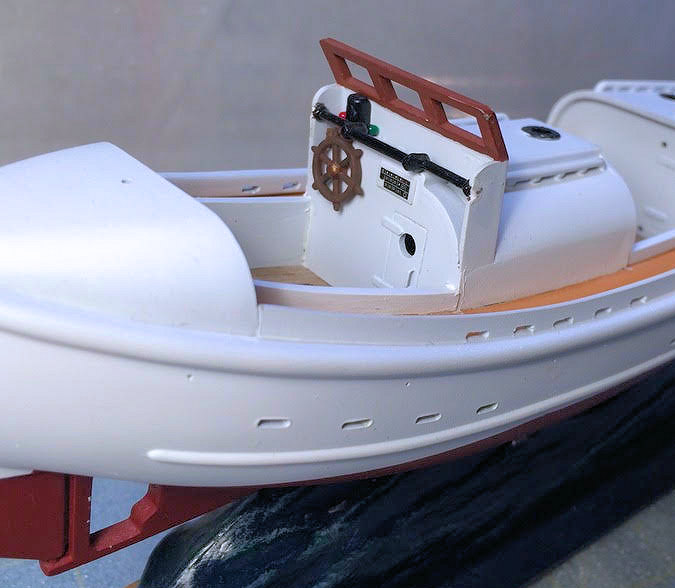 I gave a lot of thought to how
I'd rig the grab lines that needed to hang in large loops from the hull
eyelets. I know that left to it's own devices, simple thread will not hang
flat-- there's no weight to it, so it will kink and bow out and look rather
unrealistic. Plus, it would be difficult to get every loop the same size if
the thread wouldn't hang down like it had some weight to it! Here's my trick
to solve this-- I cut 12 inch long lengths of .008 diameter fine rigging
thread, and painted them with white glue diluted about 50% with water. I
then pulled the wet, slightly gluey thread between my fingers. This knocked
down any stray fibers, to prevent the line from getting the dreaded “fuzzies”.
I then put a clamp on the end of the thread and hung it vertically until it
dried. I now had a length of thread that was stiffer, like soft wire, that
would keep any shape I formed it in, but still looked like a rope product. I
was then able to thread the line though the eyelets, and shape it so that
the loops were uniform. A dab of CA locked it all in place.
I gave a lot of thought to how
I'd rig the grab lines that needed to hang in large loops from the hull
eyelets. I know that left to it's own devices, simple thread will not hang
flat-- there's no weight to it, so it will kink and bow out and look rather
unrealistic. Plus, it would be difficult to get every loop the same size if
the thread wouldn't hang down like it had some weight to it! Here's my trick
to solve this-- I cut 12 inch long lengths of .008 diameter fine rigging
thread, and painted them with white glue diluted about 50% with water. I
then pulled the wet, slightly gluey thread between my fingers. This knocked
down any stray fibers, to prevent the line from getting the dreaded “fuzzies”.
I then put a clamp on the end of the thread and hung it vertically until it
dried. I now had a length of thread that was stiffer, like soft wire, that
would keep any shape I formed it in, but still looked like a rope product. I
was then able to thread the line though the eyelets, and shape it so that
the loops were uniform. A dab of CA locked it all in place.
The lifelines that run between the cabins were made using the same treated thread, anchored on a set of Bob's Buckles at each end. To simulate the turnbuckles, I put a short piece of .3mm ID brass tube at each end.
The canvas cover over the cockpit is a thick plastic molding, while the actual cover was a thin canvas stretched over a folding metal frame, sort of like a convertible top on a car. The piece has some faint raised lines on the inside of the cover where the frame would go. I glued some small half-round stock on the inside to represent the frames and painted it black. That, couple with some sanding to thin the trailing edge, makes the piece look better. I should have taken some more pictures of the detail I added to the helm-- as it is hard to see it once the awning was installed!
One the real boat, the bitt mounted on the forward bulkhead of the steering gear compartment is basically a 4x4 inch wood post with a short metal crosspiece passing through it. I took the kit part, and cut the fragile little plastic cross pieces off. I then drilled a small hole, and used a short piece of brass rod as the cross piece. This gave me a sturdy post to attach the lines that stretched the canvas cover tight.
| COLORS AND MARKINGS |
The model was painted with
Tamiya and Model Master acrylics. I first primed the brown plastic with Tamiya
light gray primer in the spray can. I then airbrushed the model with Tamiya flat
white. After it dried, I masked the waterline and painted the lower hull dark
hull red. One thing I found in researching the 36 footers is that there was a
lot of variation in how the waterline was painted-- the black boot topping
ranged from non-existent to a thin stripe to a thick
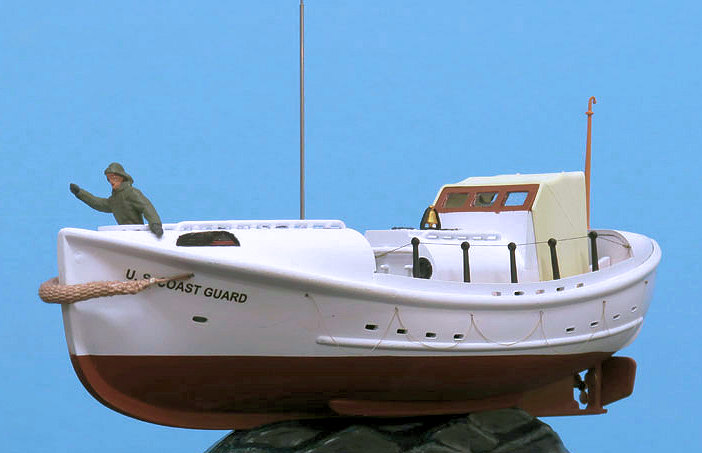 band. In the few pictures
of 36500 from the SS Pendleton
rescue, I can't tell if it had one or not, so I left it off.
band. In the few pictures
of 36500 from the SS Pendleton
rescue, I can't tell if it had one or not, so I left it off.
A tricky part in painting USCG boats and cutters is the tan color used for masts and other trim. The color is named “Spar” and is FS 10371. That color is not available in any model paint line, but Model Master's Deck Tan is very close. I used that color to paint the sheer deck and the flagstaff.
My copy of the kit did not come with decals. But it was easy enough to create most of them. In 1952, the boats were marked with “U.S. COAST GUARD” at the bow, and the station name at the stern. It was easy to create the lettering on my computer, and my friend and clubmate Pip Moss printed them onto clear decal paper.
In the 1950s, the MLBs also were marked with their Station's radio call sign. The lettering was placed on the top of the midship cabin, in orange letters on a black background. Station Chatham's call sign was “NSDF”. It was easy to create the necessary graphic on my computer, but my printer wasn't up to the task of printing it on decal paper. My friend Pip tried, and he couldn't get a good decal either- the edge where the orange met the black just wasn't sharp enough.
Pip came up with a better solution-- using a two-part approach. Using clear decal paper, he printed the graphic in black and white. Because his printer doesn't print white, he got the black background with clear decal where the letters should be. Then, in a separate decal, he printed an orange rectangle. I applied the orange decal first, which was quite vivid on top of the model's white paint. Once that dried, I then added the black background decal on top of it. The orange showed through the clear parts of the top decal, making sharp, bright orange letters.
The wave base was fun to assemble and paint. I sanded off the raised lettering and made a decal to go there instead. I filled the small gaps in the seams, and then airbrushed the stand with a dark blue. I then drybrushed on multiple layers of paint, each coat lighter in both color and application, ending in a very light application of white. I then brushed on a couple coats of Future, to give the water a nice “wet” look. I painted the nameplate area with a light brown. When that dried, I added the decal, and sealed it with a another coat of Future.
| FINAL BITS |
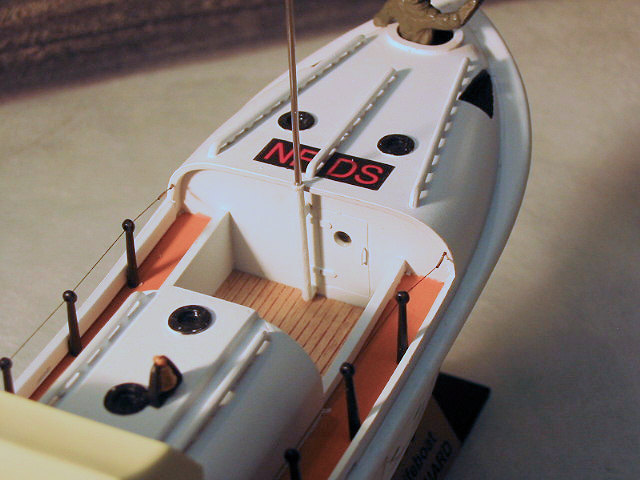 I painted the three figures, though
I only used two of them for the pictures. I've seen some builds of this model
online that show the figures with their foul weather gear painted yellow. That
isn't correct-- yellow “banana suits” were not used in the 1950s. Foul weather
gear back then was an olive drab color, not bright yellow. The helmsman isn't
wearing rain gear- he's in dungarees and a heavy sweater. I painted his clothing
shades of dark blue, dry-brushing the highlights.
I painted the three figures, though
I only used two of them for the pictures. I've seen some builds of this model
online that show the figures with their foul weather gear painted yellow. That
isn't correct-- yellow “banana suits” were not used in the 1950s. Foul weather
gear back then was an olive drab color, not bright yellow. The helmsman isn't
wearing rain gear- he's in dungarees and a heavy sweater. I painted his clothing
shades of dark blue, dry-brushing the highlights.
When I went to install him, I found that he didn't fit. My wooden grating was thicker than the kit part, enough so that it didn't leave enough headroom for the figure. I sawed the figure in half at the waist, and sanded a little plastic away, then rejoined the parts. My helmsman went from a scale 6 feet tall to something closer to 5' – 8”....!
Along the way, I broke the kit's 3 blade prop, and lost the blade. Rather than try to repair it, I found a similar prop in my spare parts bin. I painted it a dark bronze, and mounted it on a shaft made from plastic rod. The last step was to paint and install the flagstaff. I did not rig a flag, as the pictures of the 36500 mooring at the Chatham Fish Pier at the time of the Pendleton rescue do not show one flying.
| CONCLUSIONS |
Recommended, provided you understand it is a 50+ year old mold. The kit is pretty accurate in terms of shapes, but clearly benefits from some additional detailing. But even built OOB, the kit is a decent representation of the boat from the “US Coast Guard's Greatest Small Boat Rescue”.
One last note: Of interest to modelers is that the boat as restored is in her mid-late 1960s configuration, with some topside changes- most notably a pole mast with towing lights in place of the old telescoping radio antenna. (The big Dumas kit builds the boat in this configuration.) To learn more about the boat and the restoration, check out the Orleans Historical Society's website for more information at http://www.cg36500.org/
| REFERENCES |
The Finest Hours, by Michael J. Tsougias. The book is a great sea story-- highly recommended. This is the book that was the inspiration for the recent Disney film by the same name, starring Chris Pine as BM1 Bernie Webber. The film is well done, and does justice to those involved in the Pendleton rescue.
US Coast Guard History Progam: 36-Foot Motor Lifeboat- Type TRS https://www.uscg.mil/history/cutters/boats/docs/36footmlbtypetrs.pdf
Orleans Historical Society: CG36500 Gold Medal Boat http://www.cg36500.org/
US Coast Guard Historian's Office: The SS Pendelton Rescue https://www.uscg.mil/history/Pendleton_Index.asp
Thachweave Products: Bumper set for the Glencoe kit. (Not listed on the website, email them to get ordering instructions.) http://thachweave.tripod.com/index.htm
Special thanks to Pip Moss of the IPMS Patriot Chapter in Bedford, Massachusetts for his help in making the decals, and for taking all the great pictures.
4 August 2016
Copyright ModelingMadness.com
If you would like your product reviewed fairly and fairly quickly, please contact the editor or see other details in the Note to Contributors.